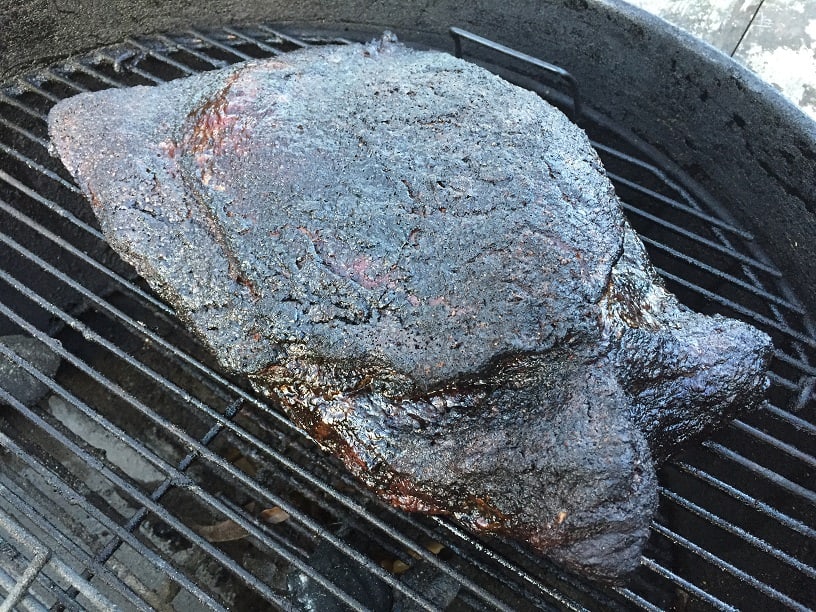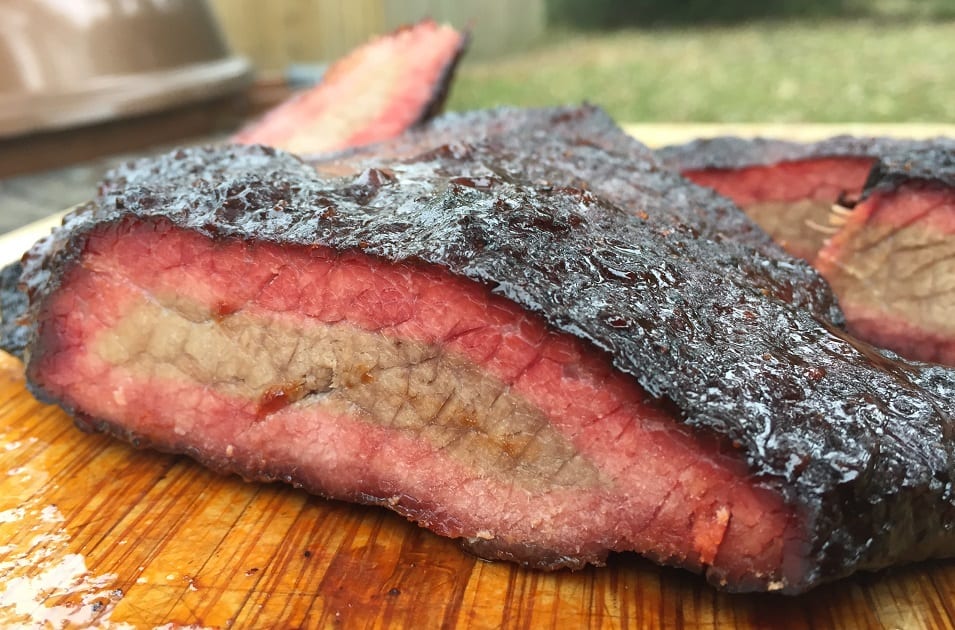When it comes to selecting smoke wood for brisket there is a general consensus that two types of woods in particular are the most appropriate. Which of the woods to use, or even the combination of both, will come down to your style of barbecue and the equipment that you are using.
The two best woods for smoking brisket are oak and hickory. These are the types of wood used by some of the top competition barbecue teams in the country as well as the pitmasters at iconic Texas barbecue restaurants. These are all people that earn their living by smoking the best meat in the country. I always say that if you want to know what works the best then simply follow the money!
Let’s take a look at some data points to determine how much oak and how much hickory you should be using in your barbecue pit.

Use Hickory and Oak for Smoking Brisket
- Daniel Vaughn wrote a great article for Texas Monthly that broke down the brisket recipes from 22 of his favorite barbecue books. In his analysis oak and hickory were the two clear pitmaster favorites although there was some love shown for pecan, apple and mesquite.
- Another article published in the Dallas Observer took the pulse of the barbecue joints in Dallas and found that the pitmasters were split between oak and hickory and were rather passionate about their choice.
- The Winningest Man in Barbecue, Myron Mixon, uses a combination of oak and hickory for his competition winning brisket.
- The most famous brisket cook in Texas, Aaron Franklin, uses oak for his briskets.
These woods have distinctly different flavor profiles.
- Well seasoned Oak, and Post Oak in particular, burns very cleanly with little smoke and produces a mild sweet flavor.
- Hickory has a much stronger smokey flavor than oak as it does not burn as clean.
If you think about the methods these people use to smoke briskets then the differences in the wood choices become more obvious.
Aaron Franklin smokes his briskets a long time (8-12 hours) using post oak. Aaron needs a consistent mild smoke that will not overpower the meat.
Myron Mixon cooks his briskets quickly. The brisket is exposed to smoke for only 2-3 hours before being wrapped in a foil pan. Since the exposure time is so short Myron needs a more powerful smoke flavor from his wood and he uses a combination of oak and hickory.
Make sense?

Types of Wood For Backyard Brisket Cooks
Just because the professionals are using oak and hickory doesn’t mean that it is the best choice for you. Most backyard cooks are cooking briskets in electric smokers, propane smokers, pellet grills or Weber Smokey mountain cookers and are not using stick burning offset smokers like the professionals.
Electric and propane smokers use wood chips and smolder them in batches producing intermittent billows of smoke. It is HARD to get a great smoke profile using this method and using a mild wood like oak will only make it harder.
Even people using pellet smokers struggle to get a strong smoke profile and will often resort to injecting their briskets with a little liquid smoke.
If you are using a propane or electric smoker then don’t be afraid to kick things up and use wood chips made from hickory, pecan or even mesquite. If you are limited in how much smoke you can make then you need to make the most out of the little that you have.
If you are using a Weber Smokey Mountain, drum smoker or other charcoal burning cooker then put on a couple wood chunks of hickory and a couple chunks of oak. By the way, if you can’t find oak then maple is an excellent substitute.
If you are using a pellet smoker then you need to pay close attention to the brand of pellets you are using. Many pellet manufacturers will write “Hickory” in bold letters on the bag but when you look closer you will see that it is actually “Hickory Flavor” with the pellet being 80% oak and 20% hickory. If you are cooking with pellets then you need to check out my article on the best wood pellets for smoking meat.
Use The Wood That You Like
I like to say that there are no absolute rules to making great barbecue and this is no exception.
For example, Melissa Cookston is a multiple barbecue World Champion and also a highly successful restaurateur. She really does not care for hickory and prefers cooking over apple and cherry. For her restaurant she cooks over pecan because that is what her customers like the most.
Personally I love using cherry when I cook briskets. I love the flavor and color that I get from cherry and is something that makes my briskets a little different than everyone else’s. Since cherry is also a great wood for smoking ribs I can keep a single wood supply on hand and be covered for just about everything.
Don’t Use Too Much Smoke
Regardless of which wood you end up using my biggest tip is the same: Do not use too much smoke on the meat. A brisket that has been cooked in billowing white smoke is going to taste harsh and bitter. One that has been cooked in thin blue smoke will be sweet and succulent.
If your smoker is sending out lots of white smoke then it means the fire is struggling to burn clean. Open up your air vents to give the fire more oxygen to burn. Don’t worry if your smoker shoots above your target temperatures as brisket is a very forgiving meat as long as there is not a lot of sugar in the dry rub.
There are several reasons that professional pitmasters wrap their briskets in aluminum foil or butcher paper at some point during the cook. Wrapping a brisket speeds up the cook and protects both the color and flavor of the surface from becoming saturated with smoke. When they wrap is highly dependent upon whether they are cooking low and slow or hot and fast but, in general, they tend to wrap shortly after the rub has set and the brisket has taken on a beautiful mahogany color.
Some people call wrapping a brisket the Texas Crutch. I call it a smart way to manage the brisket’s flavor profile.

